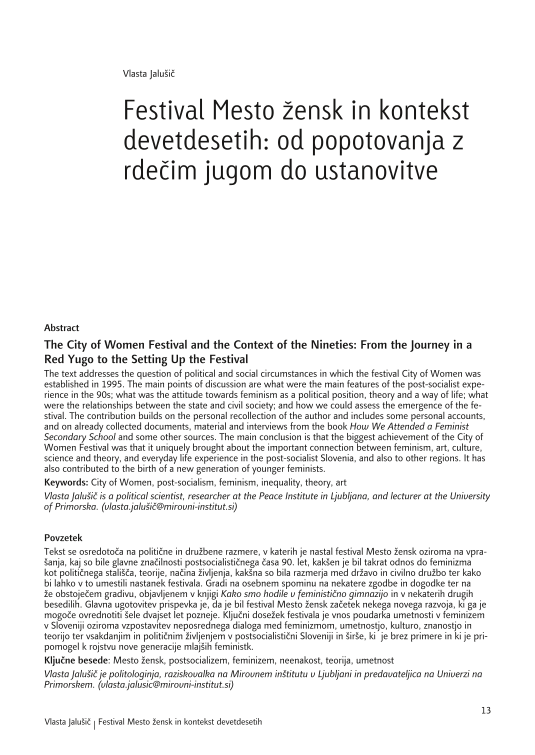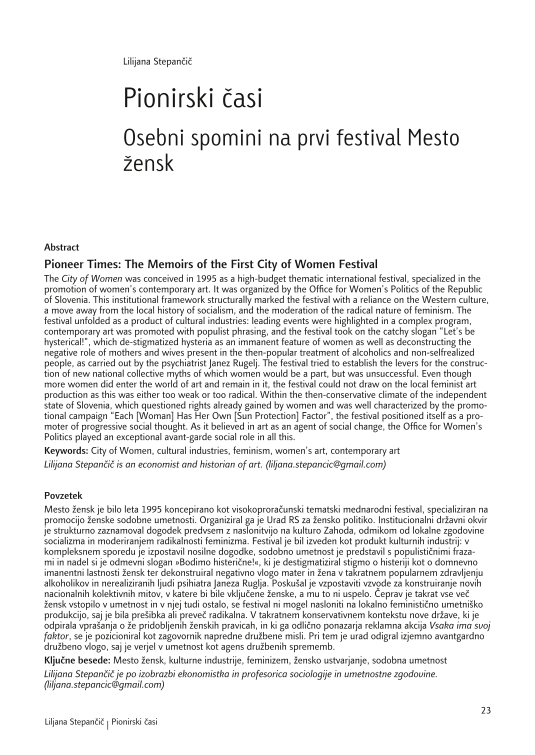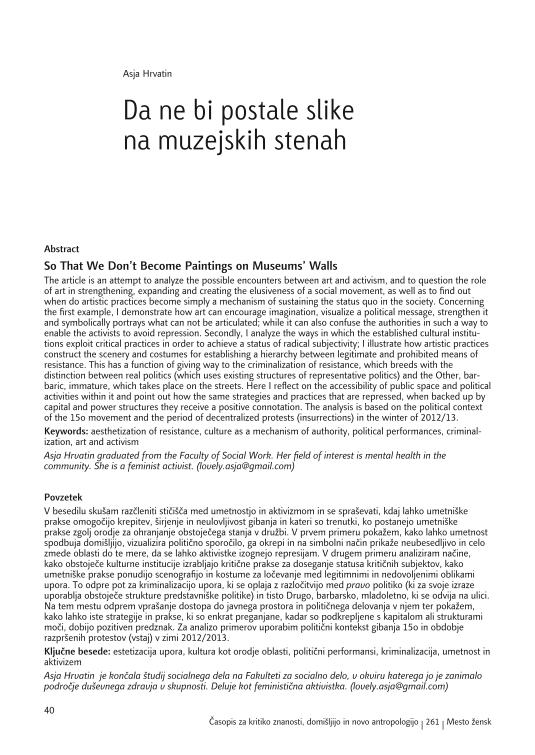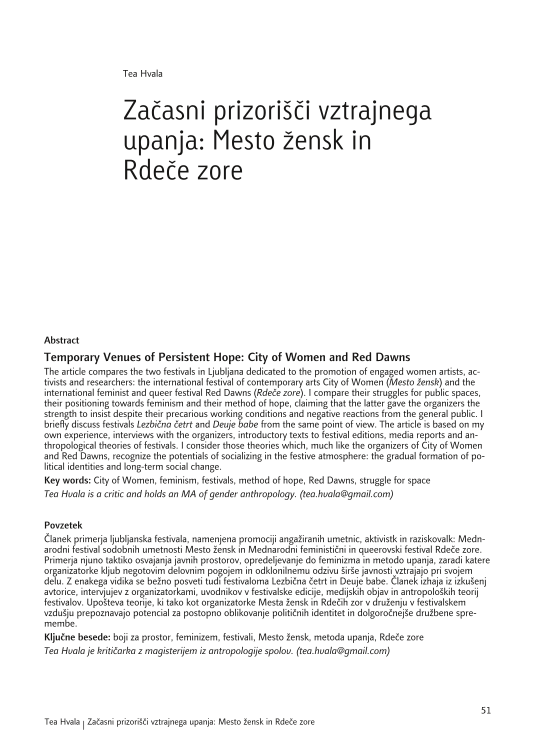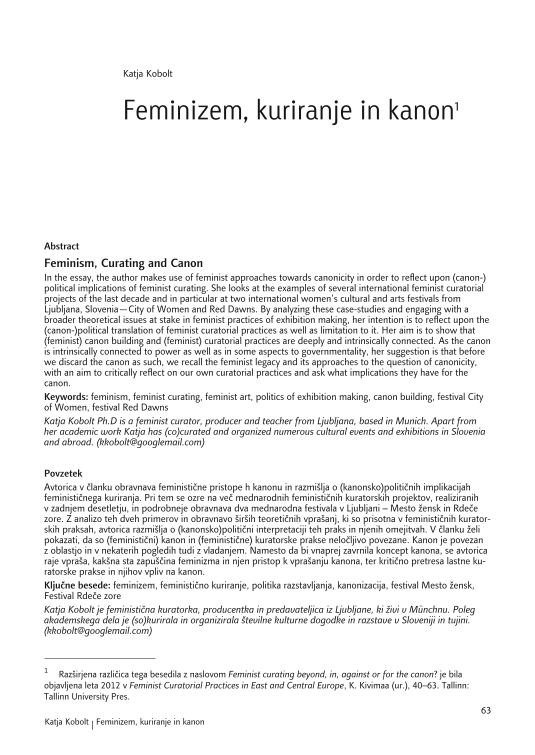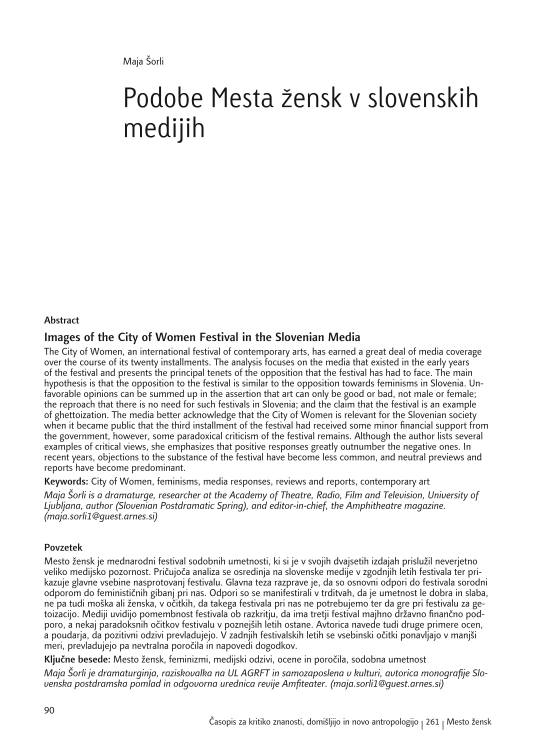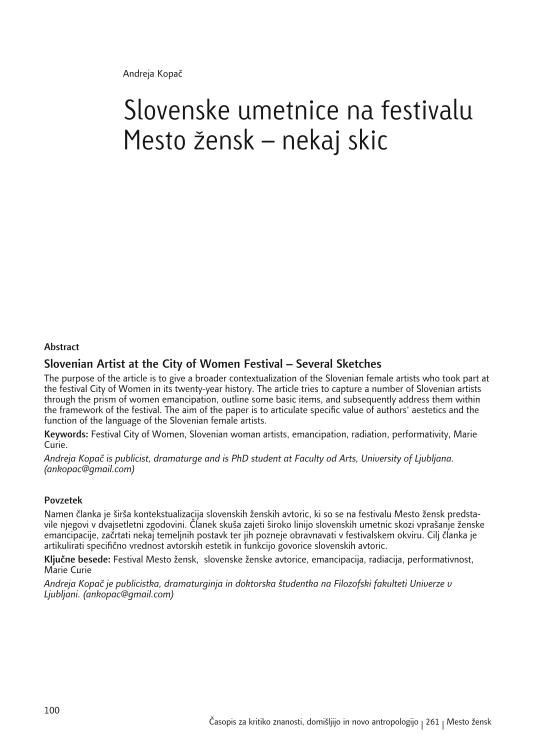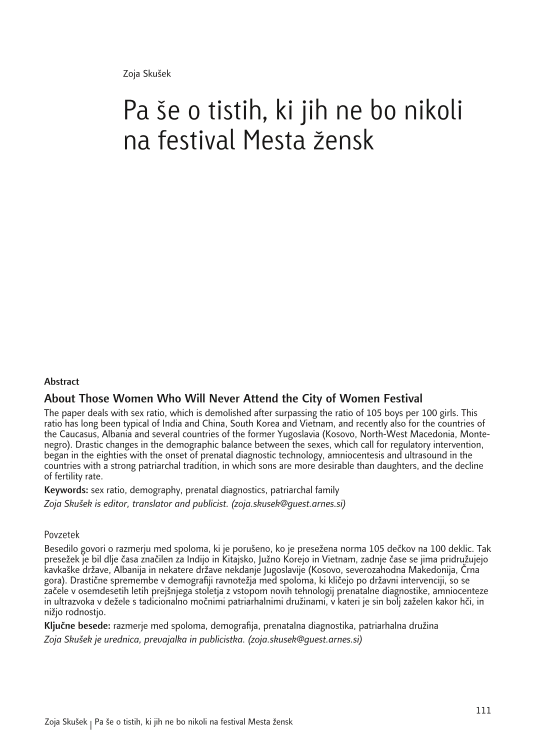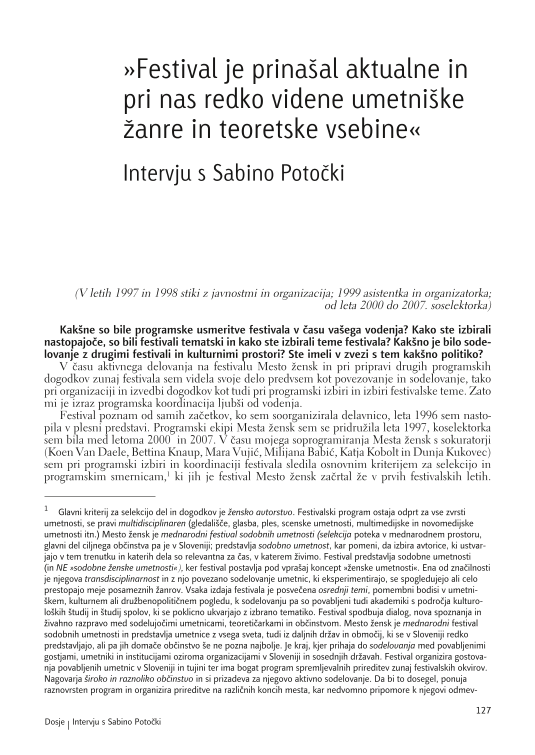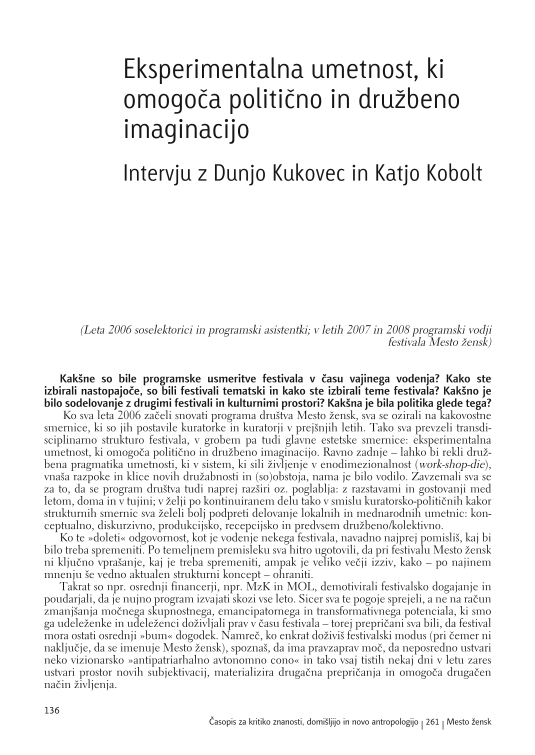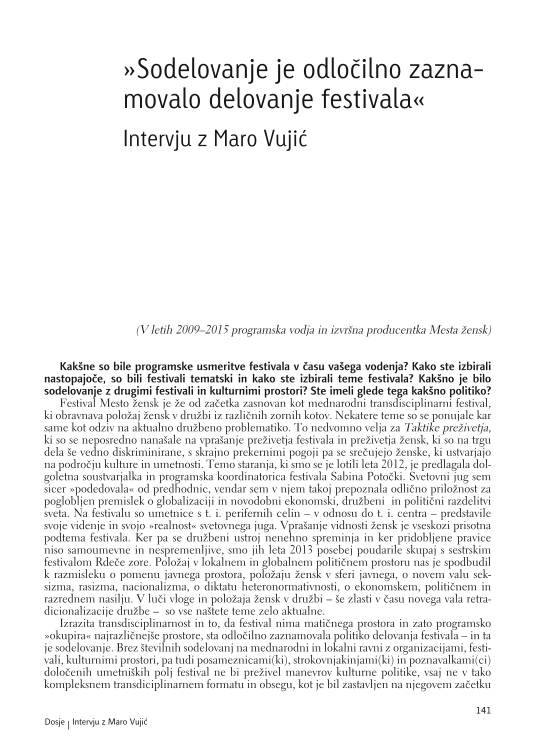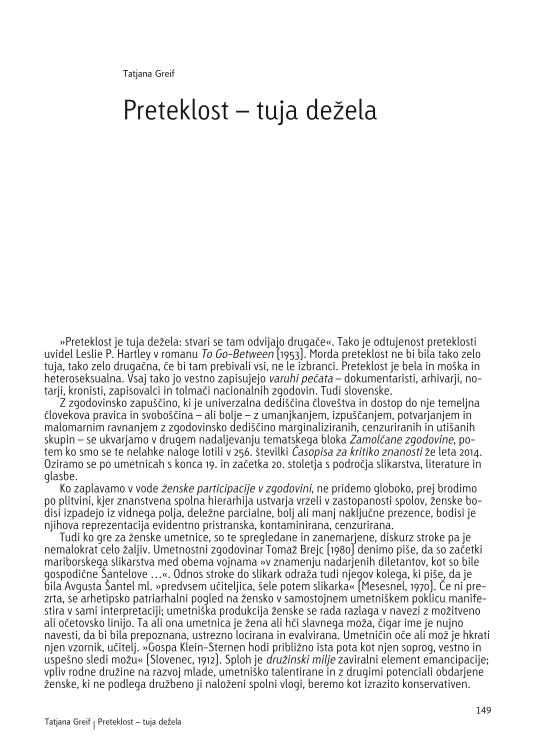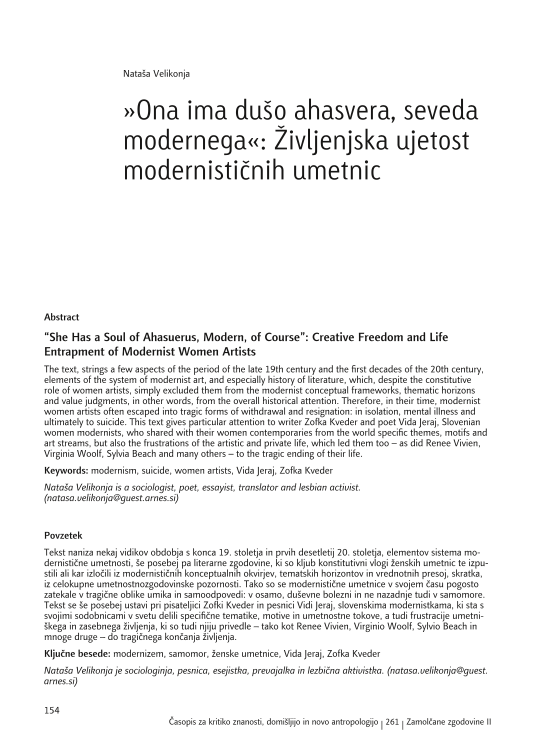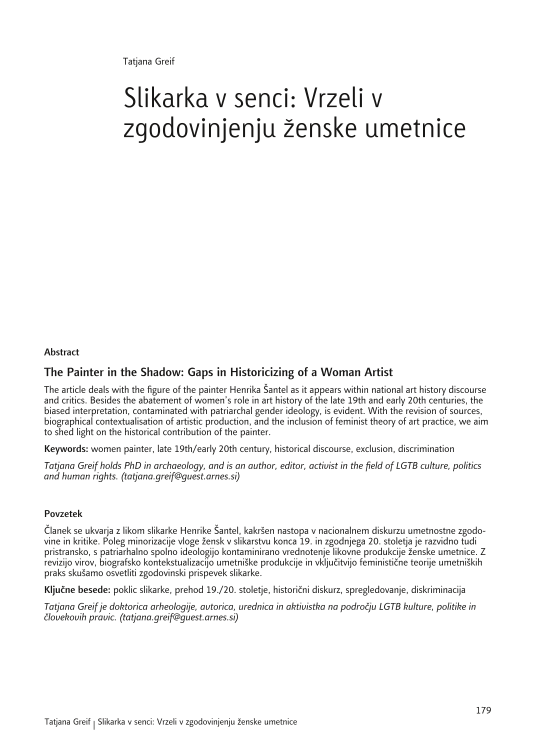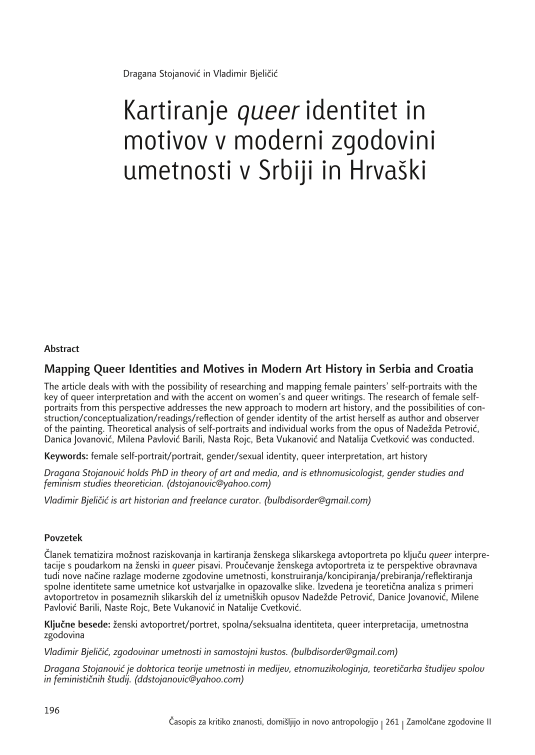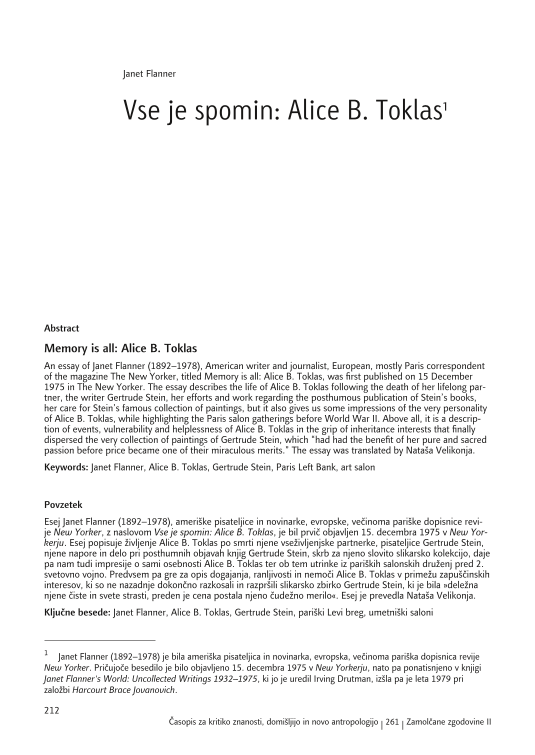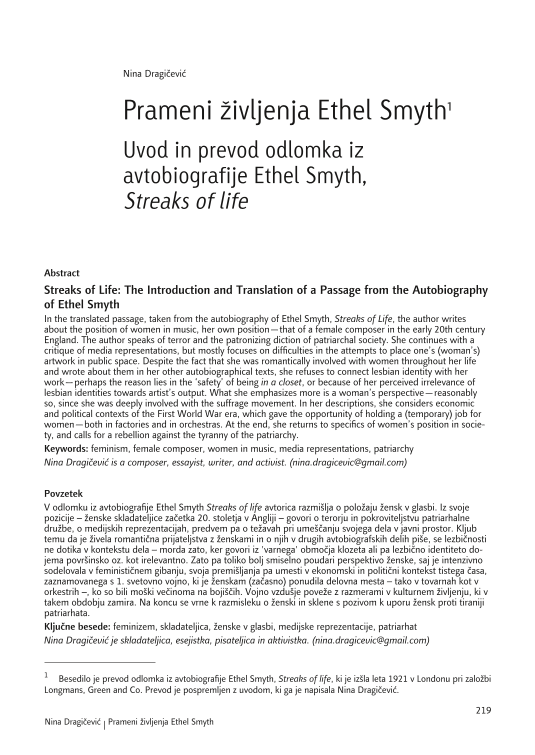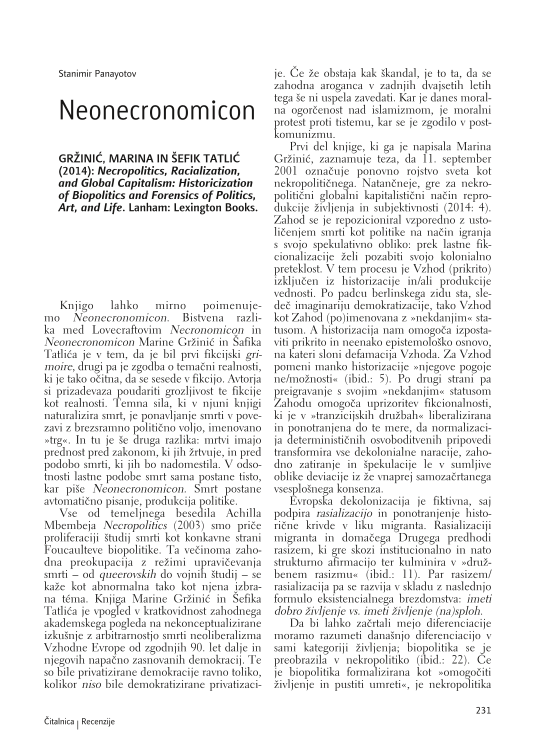V letu 2014 smo praznovali 20-letnico festivala Mesto žensk (v nadaljevanju Mesto žensk) in v letu 2015 praznujemo 20. obletnico ustanovitve društva Mesto žensk – Društvo za promocijo žensk v kulturi. Dvajset let delovanja društva, ki nikoli ni bilo del kulturnega mainstreama, je dolgo obdobje. Sicer je v Sloveniji kar nekaj festivalov, ki so svoje začetke generirali v osemdesetih letih prejšnjega stoletja, torej v času gibanjskega vrenja, in kljubovali pritiskom kapitalizma devetdesetih ter razosebljenega in podivjanega neoliberalizma v zadnjem desetletju in pol. Preživeli so zgolj zaradi velike angažiranosti ustvarjalk in ustvarjalcev in zaradi zvestega občinstva, ki je festivale posvojilo ter jih ohranjalo pri življenju. Noben od teh festivalov ni preživel, ker bi ga kulturna (ali druga) politika prepoznala kot del »nacionalnega interesa«, torej kot del, ki pripomore h »kulturni samobitnosti naroda«,1 »krepi njegovo identiteto« in samozavest ter omogoča »družbeno kohezivnost«. Škoda je, da se to pozna na današnjem stanju duha, ki bi bil zagotovo bolj odprt, ustvarjalen, vključujoč in sprejemljiv za novosti in drugačnosti in zato bogatejši (seveda v nematerialnem pogledu). Država bi najbrž od tega imela več, kot ima zdaj od »gospodarske rasti« in »polne zaposlenosti«, v čemer vidi edino zveličavno odrešitev. O tem in o umeščenosti festivala v družbeno okolje govorijo prispevki avtoric, ki smo jih povabili k sodelovanju, in intervjuji, ki smo jih opravili s programskimi voditeljicami in voditeljem festivala in jih objavljamo v tej številki.
The text addresses the question of political and social circumstances in which the festival City of Women was established in 1995. The main points of discussion are what were the main features of the post-socialist experience in the 90s; what was the attitude towards feminism as a political position, theory and a way of life; what were the relationships between the state and civil society; and how we could assess the emergence of the festival. The contribution builds on the personal recollection of the author and includes some personal accounts, and on already collected documents, material and interviews from the book How We Attended a Feminist Secondary School and some other sources. The main conclusion is that the biggest achievement of the City of Women Festival was that it uniquely brought about the important connection between feminism, art, culture, science and theory, and everyday life experience in the post-socialist Slovenia, and also to other regions. It has also contributed to the birth of a new generation of younger feminists.
The City of Women was conceived in 1995 as a high-budget thematic international festival, specialized in the promotion of women’s contemporary art. It was organized by the Office for Women’s Politics of the Republic of Slovenia. This institutional framework structurally marked the festival with a reliance on the Western culture, a move away from the local history of socialism, and the moderation of the radical nature of feminism. The festival unfolded as a product of cultural industries: leading events were highlighted in a complex program, contemporary art was promoted with populist phrasing, and the festival took on the catchy slogan “Let’s be hysterical!”, which de-stigmatized hysteria as an immanent feature of women as well as deconstructing the negative role of mothers and wives present in the then-popular treatment of alcoholics and non-selfrealized people, as carried out by the psychiatrist Janez Rugelj. The festival tried to establish the levers for the construction of new national collective myths of which women would be a part, but was unsuccessful. Even though more women did enter the world of art and remain in it, the festival could not draw on the local feminist art production as this was either too weak or too radical. Within the then-conservative climate of the independent state of Slovenia, which questioned rights already gained by women and was well characterized by the promotional campaign “Each [Woman] Has Her Own [Sun Protection] Factor”, the festival positioned itself as a promoter of progressive social thought. As it believed in art as an agent of social change, the Office for Women’s Politics played an exceptional avant-garde social role in all this.
The article is an attempt to analyze the possible encounters between art and activism, and to question the role of art in strengthening, expanding and creating the elusiveness of a social movement, as well as to find out when do artistic practices become simply a mechanism of sustaining the status quo in the society. Concerning the first example, I demonstrate how art can encourage imagination, visualize a political message, strengthen it and symbolically portrays what can not be articulated; while it can also confuse the authorities in such a way to enable the activists to avoid repression. Secondly, I analyze the ways in which the established cultural institutions exploit critical practices in order to achieve a status of radical subjectivity; I illustrate how artistic practices construct the scenery and costumes for establishing a hierarchy between legitimate and prohibited means of resistance. This has a function of giving way to the criminalization of resistance, which breeds with the distinction between real politics (which uses existing structures of representative politics) and the Other, barbaric, immature, which takes place on the streets. Here I reflect on the accessibility of public space and political activities within it and point out how the same strategies and practices that are repressed, when backed up by capital and power structures they receive a positive connotation. The analysis is based on the political context of the 15o movement and the period of decentralized protests (insurrections) in the winter of 2012/13.
The article compares the two festivals in Ljubljana dedicated to the promotion of engaged women artists, activists and researchers: the international festival of contemporary arts City of Women (Mesto žensk) and the international feminist and queer festival Red Dawns (Rdeče zore). I compare their struggles for public spaces, their positioning towards feminism and their method of hope, claiming that the latter gave the organizers the strength to insist despite their precarious working conditions and negative reactions from the general public. I briefly discuss festivals Lezbična četrt and Deuje babe from the same point of view. The article is based on my own experience, interviews with the organizers, introductory texts to festival editions, media reports and anthropological theories of festivals. I consider those theories which, much like the organizers of City of Women and Red Dawns, recognize the potentials of socializing in the festive atmosphere: the gradual formation of political identities and long-term social change.
In the essay, the author makes use of feminist approaches towards canonicity in order to reflect upon (canon-) political implications of feminist curating. She looks at the examples of several international feminist curatorial projects of the last decade and in particular at two international women’s cultural and arts festivals from Ljubljana, Slovenia—City of Women and Red Dawns. By analyzing these case-studies and engaging with a broader theoretical issues at stake in feminist practices of exhibition making, her intention is to reflect upon the (canon-)political translation of feminist curatorial practices as well as limitation to it. Her aim is to show that (feminist) canon building and (feminist) curatorial practices are deeply and intrinsically connected. As the canon is intrinsically connected to power as well as in some aspects to governmentality, her suggestion is that before we discard the canon as such, we recall the feminist legacy and its approaches to the question of canonicity, with an aim to critically reflect on our own curatorial practices and ask what implications they have for the canon.
The contribution discusses the conditions of production of a Slovenian art festival City of Women in relation to cultural policy. Arguing that the festival is socially subordinated on several levels, in that it presents female artists and belongs to the independent/non-governmental cultural sector, I approach the festival’s economic situation by contrasting the disproportion between the public funding it receives and the scope of the festival’s artistic program and its larger cultural significance. The article demonstrates that cultural policy underfinances City of Women, which is in turn run mostly through unpaid cultural labor. The essay in turn discusses the festival in terms of the transformation of social policy for women into cultural policy, drawing a comparison between unpaid domestic labor and unpaid cultural labor. In conclusion, I interpret the festival’s economic conditions as an effect of class struggle in Slovenia during the transition from socialism in the 1980s to neoliberalism at the end of the 1990s, which resulted in the unsuccessful transformation of the hierarchies of its cultural system and subordinated the independent scene. I argue that this reality of class relations in post-socialist Slovenia is concealed: the cultural system is seen in terms of aesthetic distinctions rather than unequal conditions of cultural production, while the socio-economic inequality of women is discussed in terms of identity politics.
The City of Women, an international festival of contemporary arts, has earned a great deal of media coverage over the course of its twenty installments. The analysis focuses on the media that existed in the early years of the festival and presents the principal tenets of the opposition that the festival has had to face. The main hypothesis is that the opposition to the festival is similar to the opposition towards feminisms in Slovenia. Unfavorable opinions can be summed up in the assertion that art can only be good or bad, not male or female; the reproach that there is no need for such festivals in Slovenia; and the claim that the festival is an example of ghettoization. The media better acknowledge that the City of Women is relevant for the Slovenian society when it became public that the third installment of the festival had received some minor financial support from the government, however, some paradoxical criticism of the festival remains. Although the author lists several examples of critical views, she emphasizes that positive responses greatly outnumber the negative ones. In recent years, objections to the substance of the festival have become less common, and neutral previews and reports have become predominant.
The purpose of the article is to give a broader contextualization of the Slovenian female artists who took part at the festival City of Women in its twenty-year history. The article tries to capture a number of Slovenian artists through the prism of women emancipation, outline some basic items, and subsequently address them within the framework of the festival. The aim of the paper is to articulate specific value of authors' aestetics and the function of the language of the Slovenian female artists.
The paper deals with sex ratio, which is demolished after surpassing the ratio of 105 boys per 100 girls. This ratio has long been typical of India and China, South Korea and Vietnam, and recently also for the countries of the Caucasus, Albania and several countries of the former Yugoslavia (Kosovo, North-West Macedonia, Montenegro). Drastic changes in the demographic balance between the sexes, which call for regulatory intervention, began in the eighties with the onset of prenatal diagnostic technology, amniocentesis and ultrasound in the countries with a strong patriarchal tradition, in which sons are more desirable than daughters, and the decline of fertility rate.
In its twenty years of existence, the City of Women Festival was curated by seven program directors (6 women and a man) and was created together with many other staff members. In the dossier, we publish interviews with directors who curated festival in socially and politically different periods and inside different cultural politics. Szczerski (2012) says that curating can be made in at least two different directions. The first is the socially and politically engaged direction, which uses or presents art to provoke social and political debates. The second insists on curating as an expertise in art— a curator does not preach but judge on taste. The interviews show that curating the City of Women festival mostly adopts the first direction, but does not avoid the second. None of the festivals were exclusively a personal project of a curator, but the program always expressed personal preferences and views. This is what differentiates festivals between themselves, even though they are based on the same program guidelines. We conceptualized questions for the interviews to explicate the impact curators had on the program through their choices of participating artists. We were particularly interested in how annual festivals integrated or responded to social realities; how these realities were politicized through the program and art practices; and especially what was the attitude towards gender and feminism because the fact that the festival aims to promote women in art is political by itself.
(V letih 1995–1998 umetniška direktorica in voditeljica projekta)
Kakšne so bile programske usmeritve festivala v času vašega vodenja? Kako ste izbirali nastopajoče, so bili festivali tematski in kako ste izbirali teme festivala? Kakšno je bilo sodelovanje z drugimi festivali in kulturnimi prostori? Ste imeli v zvezi s tem kakšno politiko?
Nekaj let pred prvim festivalom Mesto žensk sem obiskala ženski gledališki festival v okviru aktivnosti Magdalena Project v Cardiffu, ki je name naredil izjemno močan vtis. Ogledala sem si številne gledališke predstave, ki so jih ustvarile gledališke režiserke. Ženske so bile tedaj v gledališču kot režiserke v manjšini. Zanimivost tega festivala je bila, da so ga organizirale samo ženske, ki so bile edini spol tudi v tehničnih ekipah predstav, obvladovale so tako sceno kot luč in ton. Na tem festivalu moški niso bili dobrodošli.
"We wanted the festival to be a platform for dialogue and encounters" Interview with Koen Van Dael
(
(Leta 1995 selektor za gledališče in glasbo; v letih 1996–2001 selektor in organizator programa; leta 2002 član selektorske in produkcijske ekipe)
Kakšne so bile programske usmeritve festivala v času vašega vodenja? Kako ste izbirali nastopajoče, so bili festivali tematski in kako ste izbirali teme festivala? Kakšno je bilo sodelovanje z drugimi festivali in kulturnimi prostori? Ste imeli v zvezi s tem posebno politiko?
Na festivalu Mesto žensk sem sodeloval osem let in v teh letih je festival vseskozi še nastajal in se razvijal. Začeli smo kot projekt vladnega Urada za žensko politiko. To zelo pomembno dejstvo je bilo del našega koncepta na začetku, ker smo hoteli, da je festival letni opomnik temeljne nepravičnosti in načelne slabe zastopanosti oz. nereprezentiranosti žensk v umetnosti. Pri organizaciji prvega festivala leta 1995, ki je trajal samo pet dni, imeli pa smo okoli 60 dogodkov, smo bili pozorni na to, da smo bili prisotni v vseh različno profiliranih prostorih: tako se je program odvijal v alternativnih prostorih na eni strani, na drugi pa v glavni kulturni katedrali, Cankarjevem domu. S tem smo hoteli sporočiti, da ženske v umetnosti in kulturi niso slabo zastopane oz. nereprezentirane samo v določenem delu kulturne produkcije, npr. v filmu, literaturi, gledališču, temveč da se to dogaja na vseh področjih in tudi ne samo v mainstreamu, temveč tudi v alternativi. Torej, naš glavni namen je bil, da naredimo relevanten, interdisciplinarni umetniški festival, pri katerem bomo uporabili enaka selekcijska merila kot vsi drugi relevantni mednarodni umetniški festivali z majhno, a pomembno razliko: izbirali bomo med ženskimi ustvarjalkami, umetnicami, in s tem opozorili na nepravičnost. Predstavljajte si, ste recimo programski vodja ljubljanskega filmskega festivala Life, v program vseh sekcij (Perspektive, Kralji in kraljice, Ekstravaganca, Premiere itd.) pa boste izbrali samo avtorice. Kakšen bo ta program? To je bila osnovna ideja, o kateri se je prvo leto v javnosti najbolj odkrito in neposredno govorilo.
(V letih 1997 in 1998 stiki z javnostmi in organizacija; 1999 asistentka in organizatorka; od leta 2000 do 2007. soselektorka)
Kakšne so bile programske usmeritve festivala v času vašega vodenja? Kako ste izbirali nastopajoče, so bili festivali tematski in kako ste izbirali teme festivala? Kakšno je bilo sodelovanje z drugimi festivali in kulturnimi prostori? Ste imeli v zvezi s tem kakšno politiko?
V času aktivnega delovanja na festivalu Mesto žensk in pri pripravi drugih programskih dogodkov zunaj festivala sem videla svoje delo predvsem kot povezovanje in sodelovanje, tako pri organizaciji in izvedbi dogodkov kot tudi pri programski izbiri in izbiri festivalske teme. Zato mi je izraz programska koordinacija ljubši od vodenja.
Festival poznam od samih začetkov, ko sem soorganizirala delavnico, leta 1996 sem nastopila v plesni predstavi. Programski ekipi Mesta žensk sem se pridružila leta 1997, koselektorka sem bila med letoma 2000 in 2007. V času mojega soprogramiranja Mesta žensk s sokuratorji (Koen Van Daele, Bettina Knaup, Mara Vujić, Milijana Babić, Katja Kobolt in Dunja Kukovec) sem pri programski izbiri in koordinaciji festivala sledila osnovnim kriterijem za selekcijo in programskim smernicam,1 ki jih je festival Mesto žensk začrtal že v prvih festivalskih letih.
"Talent and quality do not guarantee discovery, recognition or success" Interview with Bettina Knaup
(
(Leta 2001 programska svetovalka; od 2002. do 2004. koproducentka in sokuratorka)
Kakšne so bile programske usmeritve festivala v času vašega vodenja? Kako ste izbirali nastopajoče, so bili festivali tematski, in kako ste izbirali teme festivala? Kakšno je bilo sodelovanje z drugimi festivali in kulturnimi prostori? Ste imeli pri tem izoblikovano kakšno politiko?
Festivalski ekipi sem se pridružila leta 2001, ko sem bila sodelavka in programska svetovalka, financirana s strani Goethejevega inštituta. Med letoma 2002 in 2004 sem delala kot koproducentka in sokuratorka (leta 2002 s Koenom van Dealom in Sabino Potočki; v letih 2003 in 2004 s Sabino Potočki). Deloma sem delala v Ljubljani, deloma iz Berlina.
Glede na to, da je bil takrat glavni cilj Društva Mesto žensk izzvati razpravo in ozaveščanje o pod- in slabi reprezentiranosti žensk v umetnosti in da je deloval kot letni opomnik o tem, da talent in kakovost ne zagotavljata odkritja, priznanja ali uspeha, smo izbrali širok interdisciplinarni program samo ženskih umetnic/avtoric. To seveda ni izključevalo moških igralcev, performerjev in sodelavcev, ki so sodelovali v delih umetnic.
Experimental art that enables political and social imagination. Interview with Dunja Kukovec and Katja Kobolt
(
(Leta 2006 soselektorici in programski asistentki; v letih 2007 in 2008 programski vodji festivala Mesto žensk)
Kakšne so bile programske usmeritve festivala v času vajinega vodenja? Kako ste izbirali nastopajoče, so bili festivali tematski in kako ste izbirali teme festivala? Kakšno je bilo sodelovanje z drugimi festivali in kulturnimi prostori? Kakšna je bila politika glede tega?
Ko sva leta 2006 začeli snovati programa društva Mesto žensk, sva se ozirali na kakovostne smernice, ki so jih postavile kuratorke in kuratorji v prejšnjih letih. Tako sva prevzeli transdisciplinarno strukturo festivala, v grobem pa tudi glavne estetske smernice: eksperimentalna umetnost, ki omogoča politično in družbeno imaginacijo. Ravno zadnje – lahko bi rekli družbena pragmatika umetnosti, ki v sistem, ki sili življenje v enodimezionalnost (work-shop-die), vnaša razpoke in klice novih družabnosti in (so)obstoja, nama je bilo vodilo. Zavzemali sva se za to, da se program društva tudi naprej razširi oz. poglablja: z razstavami in gostovanji med letom, doma in v tujini; v želji po kontinuiranem delu tako v smislu kuratorsko-političnih kakor strukturnih smernic sva želeli bolj podpreti delovanje lokalnih in mednarodnih umetnic: konceptualno, diskurzivno, produkcijsko, recepcijsko in predvsem družbeno/kolektivno.
"Cooperation has made a decisive difference to the Festival" Interview with Mara Vujić
(
(V letih 2009–2015 programska vodja in izvršna producentka Mesta žensk)
Kakšne so bile programske usmeritve festivala v času vašega vodenja? Kako ste izbirali nastopajoče, so bili festivali tematski in kako ste izbirali teme festivala? Kakšno je bilo sodelovanje z drugimi festivali in kulturnimi prostori? Ste imeli glede tega kakšno politiko?
Festival Mesto žensk je že od začetka zasnovan kot mednarodni transdisciplinarni festival, ki obravnava položaj žensk v družbi iz različnih zornih kotov. Nekatere teme so se ponujale kar same kot odziv na aktualno družbeno problematiko. To nedvomno velja za Taktike preživetja, ki so se neposredno nanašale na vprašanje preživetja festivala in preživetja žensk, ki so na trgu dela še vedno diskriminirane, s skrajno prekernimi pogoji pa se srečujejo ženske, ki ustvarjajo na področju kulture in umetnosti. Temo staranja, ki smo se je lotili leta 2012, je predlagala dolgoletna soustvarjalka in programska koordinatorica festivala Sabina Potočki. Svetovni jug sem sicer »podedovala« od predhodnic, vendar sem v njem takoj prepoznala odlično priložnost za poglobljen premislek o globalizaciji in novodobni ekonomski, družbeni in politični razdelitvi sveta. Na festivalu so umetnice s t. i. perifernih celin – v odnosu do t. i. centra – predstavile svoje videnje in svojo »realnost« svetovnega juga. Vprašanje vidnosti žensk je vseskozi prisotna podtema festivala. Ker pa se družbeni ustroj nenehno spreminja in ker pridobljene pravice niso samoumevne in nespremenljive, smo jih leta 2013 posebej poudarile skupaj s sestrskim festivalom Rdeče zore. Položaj v lokalnem in globalnem političnem prostoru nas je spodbudil k razmisleku o pomenu javnega prostora, položaju žensk v sferi javnega, o novem valu seksizma, rasizma, nacionalizma, o diktatu heteronormativnosti, o ekonomskem, političnem in razrednem nasilju. V luči vloge in položaja žensk v družbi – še zlasti v času novega vala retradicionalizacije družbe – so vse naštete teme zelo aktualne.
»Preteklost je tuja dežela: stvari se tam odvijajo drugače«. Tako je odtujenost preteklosti uvidel Leslie P. Hartley v romanu To Go-Between (1953). Morda preteklost ne bi bila tako zelo tuja, tako zelo drugačna, če bi tam prebivali vsi, ne le izbranci. Preteklost je bela in moška in heteroseksualna. Vsaj tako jo vestno zapisujejo varuhi pečata – dokumentaristi, arhivarji, notarji, kronisti, zapisovalci in tolmači nacionalnih zgodovin. Tudi slovenske.
Z zgodovinsko zapuščino, ki je univerzalna dediščina človeštva in dostop do nje temeljna človekova pravica in svoboščina – ali bolje – z umanjkanjem, izpuščanjem, potvarjanjem in malomarnim ravnanjem z zgodovinsko dediščino marginaliziranih, cenzuriranih in utišanih skupin – se ukvarjamo v drugem nadaljevanju tematskega bloka Zamolčane zgodovine, potem ko smo se te nelahke naloge lotili v 256. številki Časopisa za kritiko znanosti že leta 2014. Oziramo se po umetnicah s konca 19. in začetka 20. stoletja s področja slikarstva, literature in glasbe.
Sem ena tistih brez mitologije, brez močnih ali skritih boginj za priprošnje. Ena tistih, ki pod nogami nimajo spominov drugih pokrajin razen betonskih plošč mestnih ulic. Nimam skrivnega jezika, ne globljih besed kot tistih, ki sem se jih naučila v tem svetu. Nimam spominov na viseče, debele, sočne sadeže, na gorske vrhove in doline, zaznamovane z velikimi dogodki. Ne poznam drugih rek kot tistih, ki vežejo moje dneve na ta mestni otok. Ne žalujem za izgubami, ker se ne morem pretvarjati, da sem živela, kjer nisem. Moj spomin ne seže izza dolgih osebnih let. Ne poznam imena svoje babice, zato moram iti globlje, se potapljati skozi lastna nagrmadena leta, da bi si prilastila nove starodavne fragmente.
“She Has a Soul of Ahasuerus, Modern, of Course”: Creative Freedom and Life Entrapment of Modernist Women Artists
(
The text, strings a few aspects of the period of the late 19th century and the first decades of the 20th century, elements of the system of modernist art, and especially history of literature, which, despite the constitutive role of women artists, simply excluded them from the modernist conceptual frameworks, thematic horizons and value judgments, in other words, from the overall historical attention. Therefore, in their time, modernist women artists often escaped into tragic forms of withdrawal and resignation: in isolation, mental illness and ultimately to suicide. This text gives particular attention to writer Zofka Kveder and poet Vida Jeraj, Slovenian women modernists, who shared with their women contemporaries from the world specific themes, motifs and art streams, but also the frustrations of the artistic and private life, which led them too – as did Renee Vivien, Virginia Woolf, Sylvia Beach and many others – to the tragic ending of their life.
The painter and graphic artist Elda Piščanec (1897–1967) created at the time when women became increasingly emancipated in artistic practice. She belonged to the first generation of women artists, who after long centuries can be studied at the Academy of Fine Arts, and finally began to learn painting and drawing the nude model, which consequently affected the free choice of motives. The body of work of Elda Piščanec reveals a number of works in which the author confidently portrayed naked female figures. In this article, I focus on her oil painting Two Girls, which was painted between 1930 and 1935th. With the feminist perspective, I intend to demonstrate the sexual difference in the depiction of lesbian nudes between female and male artists of that time. The painter portrayed the female naked figure in a non-sexist way in the simultaneous roles of object and subject of gaze. At the same time, this raises the question of if and how an image that was created in the early 20th century can be interpreted in the lesbian context.
The article deals with the figure of the painter Henrika Šantel as it appears within national art history discourse and critics. Besides the abatement of women’s role in art history of the late 19th and early 20th centuries, the biased interpretation, contaminated with patriarchal gender ideology, is evident. With the revision of sources, biographical contextualisation of artistic production, and the inclusion of feminist theory of art practice, we aim to shed light on the historical contribution of the painter.
The article deals with with the possibility of researching and mapping female painters’ self-portraits with the key of queer interpretation and with the accent on women’s and queer writings. The research of female self-portraits from this perspective addresses the new approach to modern art history, and the possibilities of construction/conceptualization/readings/reflection of gender identity of the artist herself as author and observer of the painting. Theoretical analysis of self-portraits and individual works from the opus of Nadežda Petrović, Danica Jovanović, Milena Pavlović Barili, Nasta Rojc, Beta Vukanović and Natalija Cvetković was conducted.
An essay of Janet Flanner (1892–1978), American writer and journalist, European, mostly Paris correspondent of the magazine The New Yorker, titled Memory is all: Alice B. Toklas, was first published on 15 December 1975 in The New Yorker. The essay describes the life of Alice B. Toklas following the death of her lifelong partner, the writer Gertrude Stein, her efforts and work regarding the posthumous publication of Stein’s books, her care for Stein’s famous collection of paintings, but it also gives us some impressions of the very personality of Alice B. Toklas, while highlighting the Paris salon gatherings before World War II. Above all, it is a description of events, vulnerability and helplessness of Alice B. Toklas in the grip of inheritance interests that finally dispersed the very collection of paintings of Gertrude Stein, which “had had the benefit of her pure and sacred passion before price became one of their miraculous merits.” The essay was translated by Nataša Velikonja.
Streaks of Life: The Introduction and Translation of a Passage from the Autobiography of Ethel Smyth
(
In the translated passage, taken from the autobiography of Ethel Smyth, Streaks of Life, the author writes about the position of women in music, her own position—that of a female composer in the early 20th century England. The author speaks of terror and the patronizing diction of patriarchal society. She continues with a critique of media representations, but mostly focuses on difficulties in the attempts to place one’s (woman’s) artwork in public space. Despite the fact that she was romantically involved with women throughout her life and wrote about them in her other autobiographical texts, she refuses to connect lesbian identity with her work—perhaps the reason lies in the ‘safety’ of being in a closet, or because of her perceived irrelevance of lesbian identities towards artist’s output. What she emphasizes more is a woman’s perspective—reasonably so, since she was deeply involved with the suffrage movement. In her descriptions, she considers economic and political contexts of the First World War era, which gave the opportunity of holding a (temporary) job for women—both in factories and in orchestras. At the end, she returns to specifics of women’s position in society, and calls for a rebellion against the tyranny of the patriarchy.
GRŽINIĆ, MARINA IN ŠEFIK TATLIĆ (2014): Necropolitics, Racialization, and Global Capitalism: Historicization of Biopolitics and Forensics of Politics, Art, and Life. Lanham: Lexington Books.
Knjigo lahko mirno poimenujemo Neonecronomicon. Bistvena razlika med Lovecraftovim Necronomicon in Neonecronomicon Marine Gržinić in Šafika Tatlića je v tem, da je bil prvi fikcijski grimoire, drugi pa je zgodba o temačni realnosti, ki je tako očitna, da se sesede v fikcijo. Avtorja si prizadevaza poudariti grozljivost te fikcije kot realnosti. Temna sila, ki v njuni knjigi naturalizira smrt, je ponavljanje smrti v povezavi z brezsramno politično voljo, imenovano »trg«. In tu je še druga razlika: mrtvi imajo prednost pred zakonom, ki jih žrtvuje, in pred podobo smrti, ki jih bo nadomestila. V odsotnosti lastne podobe smrt sama postane tisto, kar piše Neonecronomicon. Smrt postane avtomatično pisanje, produkcija politike.





